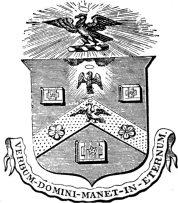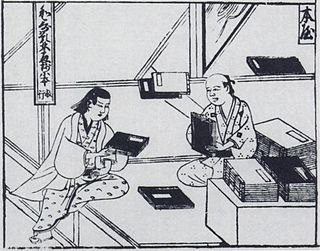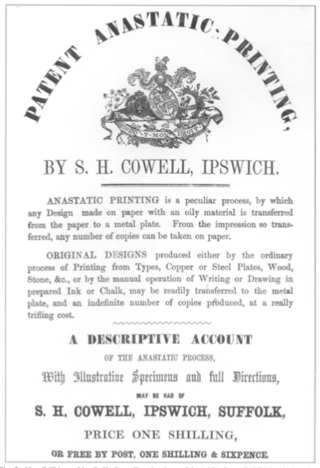
Stationery refers to commercially manufactured writing materials, including cut paper, envelopes, writing implements, continuous form paper, and other office supplies. Stationery includes materials to be written on by hand or by equipment such as computer printers.

William Bradford was an early American colonial printer and publisher in British America. Bradford is best known for establishing the first printing press in the Middle colonies of the Thirteen Colonies, founding the first press in Pennsylvania in 1685 and the first press in New York in 1693. Bradford operated continuously printing establishments for sixty-two years, heading a family that would include printers and publishers for 140 years. He was also known for controversies regarding freedom of the press. Starting his printing career in London, Bradford emigrated to America in 1685. He established, with others, the first paper mill to appear in the Thirteen American Colonies.
ReginaldWolfe was a Dutch-born English Protestant printer and one of the original members of the Royal Stationers' Company.

The Worshipful Company of Stationers and Newspaper Makers, usually known as the Stationers' Company, is one of the livery companies of the City of London. The Stationers' Company was formed in 1403; it received a Royal Charter in 1557. It held a monopoly over the publishing industry and was officially responsible for setting and enforcing regulations until the enactment of the Statute of Anne, also known as the Copyright Act of 1710. Once the company received its charter, "the company's role was to regulate and discipline the industry, define proper conduct and maintain its own corporate privileges."

John Day was an English Protestant printer. He specialised in printing and distributing Protestant literature and pamphlets, and produced many small-format religious books, such as ABCs, sermons, and translations of psalms. He found fame, however, as the publisher of John Foxe's Actes and Monuments, also known as the Book of Martyrs, the largest and most technologically accomplished book printed in sixteenth-century England.
Robert Crowley, was a stationer, poet, polemicist and Protestant clergyman among Marian exiles at Frankfurt. He seems to have been a Henrician Evangelical in favour of a more reformed Protestantism than the king and the Church of England sanctioned. Under Edward VI, he joined a London network of evangelical stationers to argue for reforms, sharing a vision of his contemporaries Hugh Latimer, Thomas Lever, Thomas Beccon and others of England as a reformed Christian commonwealth. He attacked as inhibiting reform what he saw as corruption and uncharitable self-interest among the clergy and wealthy. Meanwhile, Crowley took part in making the first printed editions of Piers Plowman, the first translation of the Gospels into Welsh, and the first complete metrical psalter in English, which was also the first to include harmonised music. Towards the end of Edward's reign and later, Crowley criticised the Edwardian Reformation as compromised and saw the dissolution of the monasteries as replacing one form of corruption by another. On his return to England after the reign of Mary I, Crowley revised his chronicle to represent the Edwardian Reformation as a failure, due to figures like Thomas Seymour, 1st Baron Seymour of Sudeley, Edward Seymour, 1st Duke of Somerset and John Dudley, 1st Duke of Northumberland. Crowley's account of the Marian martyrs represented them as a cost mostly paid by commoners. The work became a source for John Foxe's account of the period in his Actes and Monuments. Crowley held church positions in the early to mid-1560s and sought change from the pulpit and within the church hierarchy. Against the Elizabethan Religious Settlement, Crowley was a leader in the renewed vestments controversy, which eventually lost him his clerical posts. During the dispute he and other London clergy produced a "first Puritan manifesto". Late in life Crowley was restored to several church posts and appears to have charted a more moderate course in defending it from Roman Catholicism and from nonconformist factions that espoused a Presbyterian church polity.
William Seres was an English Protestant printer, starting work in about 1546, and working in partnership with John Day for a few years. Day and Seres specialized in religious works, such as those by Robert Crowley, which were largely related to theological controversies of the time. By 1550, Day and Seres were busy and successful enough to amicably separate their businesses.

Richard Pynson was one of the first printers of English books. Born in Normandy, he moved to London, where he became one of the leading printers of the generation following William Caxton. His books were printed to a high standard of craftsmanship, and his Morton Missal (1500) is regarded as among the finest books printed in England in the period.
Thomas Creede was a printer of the Elizabethan and Jacobean eras, rated as "one of the best of his time." Based in London, he conducted his business under the sign of the Catherine Wheel in Thames Street from 1593 to 1600, and under the sign of the Eagle and Child in the Old Exchange from 1600 to 1617. Creede is best known for printing editions of works in English Renaissance drama, especially for ten editions of six Shakespearean plays and three works in the Shakespeare Apocrypha.
Nicholas Okes was an English printer in London of the Jacobean and Caroline eras, remembered for printing works of English Renaissance drama. He was responsible for early editions of works by many of the playwrights of the period, including William Shakespeare, Ben Jonson, John Webster, Thomas Middleton, Thomas Dekker, Thomas Heywood, James Shirley, and John Ford.
William Stansby (1572–1638) was a London printer and publisher of the Jacobean and Caroline eras, working under his own name from 1610. One of the most prolific printers of his time, Stansby is best remembered for publishing the landmark first folio collection of the works of Ben Jonson in 1616.

William Barley (1565?–1614) was an English bookseller and publisher. He completed an apprenticeship as a draper in 1587, but was soon working in the London book trade. As a freeman of the Drapers' Company, he was embroiled in a dispute between it and the Stationers' Company over the rights of drapers to function as publishers and booksellers. He found himself in legal tangles throughout his life.
John Wolfe was an English bookseller and printer. His considerable ambition and his disdain for the printing patent system of Elizabethan England drew the ire of his competitors and authorities in his early career. After being jailed twice and having his printing materials seized, Wolfe transformed himself into an ardent defender of printing privileges. By 1593, he was appointed Printer to the City of London.
John Lewis (1912–1996) was a Welsh typographer, printer, illustrator and collector of printed ephemera.

Michiel Hillen van Hoochstraten or Michel Hillenius, was a Flemish printer, publisher, bookseller and bookbinder. His printing press put out publications in a wide range of genres, including imperial ordinances, almanacs, devotional literature, anthologies of customs, textbooks, etc. He also printed humanistic writings by Erasmus, Adrianus Barlandus and Jacobus Latomus as well as the first Dutch-language version of the story of Till Eulenspiegel. His multiple editions of the Bible in Dutch translation were among the first to be published. Michiel Hillen van Hoochstraten is regarded as the most important publisher active in Antwerp in the first half of the sixteenth century.
W.S. Cowell Ltd was a British printing company that produced a variety of books, including popular children's literature of the 1930s and prestigious coffee table books. Established in 1818, the company played a significant role in the history of printing in Ipswich. The company developed the Plastocowell printing process. However after a number of mergers in the late twentieth century, the name was finally dropped by its corporate owners in 1988.

The selling of books dates back to ancient times. The founding of libraries in c.300 BC stimulated the energies of the Athenian booksellers. In Rome, toward the end of the republic, it became the fashion to have a library, and Roman booksellers carried on a flourishing trade.
Anthony Scoloker was a translator and printer who established the first printshop in Ipswich, Suffolk. He was invited to the town by Richard Argentine, with whom he worked on three Protestant tracts. He produced six books with an Ipswich imprint before returning to London.

Samuel Harrison Cowell was a Suffolk businessman who pioneered anastatic lithography in Ipswich. Cowell issued leaflets at the Great Exhibition in 1851 to advertise the new technology.
John Oswen was an English printer.









